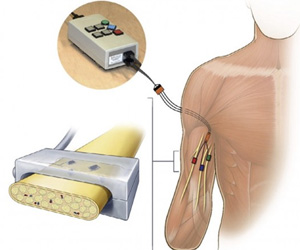“In some ways this is analogous to doing a smart search with a search engine such as Google, where the search terms one uses guide the search. We inject the agent into a small peripheral vein and it circulates throughout the human body on its search for clots.” If it doesn’t find any clots, then it’s rapidly excreted from the body; however, if it finds a clot and binds to it, clinicians can detect it with an imaging technique known as positron emission tomography.
Sosnovik and his colleagues first examined how the agent reacts (specifically, its metabolism and pharmacokinetics) in eight healthy volunteers. After injection, the agent was initially stable within the body and then was cleared from tissues within several hours, suggesting that it was safe. Next, the team administered the agent to patients with atrial fibrillation, some with clots in the heart and some without.
“Obviously much more work and many more studies will need to be done before this changes routine clinical practice, but this first-in-human study is an important step,” says Sosnovik. “Importantly, this smart or molecularly targeted agent can be used to detect clots anywhere in the body.”
Sosnovik stressed that the multidisciplinary nature of this project was critical to its success, with vital roles played by diverse scientists, including Peter Caravan, PhD, who invented and developed the study’s agent and is the co-director of MGH’s Institute for Innovation in Imaging. “This probe was invented and optimized in my laboratory by a dedicated team of chemists and biologists through the support of the National Heart Lung and Blood Institute of the National Institutes of Health,” says Caravan. “It is extremely gratifying to see these years of effort come to fruition with a fibrin-specific PET probe with the potential to make a real impact on human health.”
Others playing a major role in the study included David Izquierdo-Garcia, PhD, an assistant in Biomedical Engineering at MGH, and Ciprian Catana, MD, PhD, director of Integrated MR-PET Imaging at MGH’s Martinos Center for Biomedical Imaging. Izquierdo-Garcia, the lead author on the paper, and Catana both stressed the innovative nature of the imaging platform used in the study. “Not only did we use a novel molecular imaging probe in humans for the first time, but also, this is one of the first studies to fully explore the synergies and advantages of integrated PET-MRI scanners,” says Izquierdo-Garcia.
“It is a privilege to work at the Martinos Center for Biomedical Imaging and be part of multidisciplinary teams that collaborate to develop and apply cutting-edge imaging technologies,” adds Catana. “We were the first site in the U.S. to install a fully integrated PET-MRI scanner and have played a major role in the advancement and clinical translation of this technology.”
Source: Eurekalert



